Heavy lift items and project cargoes
Project Cargo is a term used to broadly describe the national or international transportation of large, heavy, high value or critical (to the project they are intended for) pieces of equipment. Also commonly referred to as Heavy lift, this includes shipments made of various components which require disassembly for shipment and reassembly after delivery.
Contractual issues and risk allocation
In May 2009, the International Council of Heavy Lift and Project Cargo Carriers (the “Heavy Lift Club”) was established in order to create a forum for exchanging ideas on industry issues that concern carriers operating in the heavy lift and project cargo sector. The creation of the Heavy Lift Club reflected the concern by major players in this specialized area that technical, operational and safety considerations relating to their market were not always properly understood.
Apart from the practical considerations that arise in relation to heavy lift cargoes, there are also diverse contractual needs in the heavy lift sector that need to be met. To assist those entering into charter-parties for heavy lift cargoes in identifying suitable terms to govern their contracts of carriage, BIMCO has produced two heavy lift forms, which are both classed as special voyage charter parties for the heavy lift trade. However, there are significant differences in their application and use.
 Cargo can come completely encased in wooden boxes for protection.
Cargo can come completely encased in wooden boxes for protection.
Knock for Knock or Hague / H-V Rules
One primary difference is the applicable liability regime and whether the form incorporates a knock-for-knock regime or the Hague/Hague-Visby Rules. Under a knock-for-knock contract, each contracting party bears the responsibility for its own personnel and property without recourse to its counterparty, irrespective of fault. By contrast, the Hague/Hague-Visby Rules impose on the carrier an obligation to exercise due diligence to provide a seaworthy vessel and to properly carry, keep and care for the cargo.
HEAVYCON 2007
BIMCO’s HEAVYCON 2007 voyage charter party form is a re-issued and revised version of the original 1985 form and is accompanied by its own bill of lading. It is a knock-for-knock contract designed primarily for use by semi-submersible vessels in the super-heavy lift (float-on/float off) market where cargoes are almost always loaded on deck and are usually sole cargoes. The HEAVYCON terms are flexible in that they cover a variety of loading and discharging methods as well as single or multiple loading and discharging ports.
Whilst the HEAVYCON is also used to a certain extent in the midsized (lift-on/lift-off and roll-on/roll-off) sector, it is less appropriate for that market. This is partly due to the fact that its knock-for-knock liability regime is considered unsuitable for cargo in the midsized sector, which is often split 50/50 between cargo carried both on and below deck. Such conventional cargo is generally more suited to the Hague/Hague-Visby Rules regime. As a result, BIMCO developed the HEAVYLIFTVOY.
A sample copy of the HEAVYCON 2007 can be found on BIMCO’s website https://www.bimco.org/
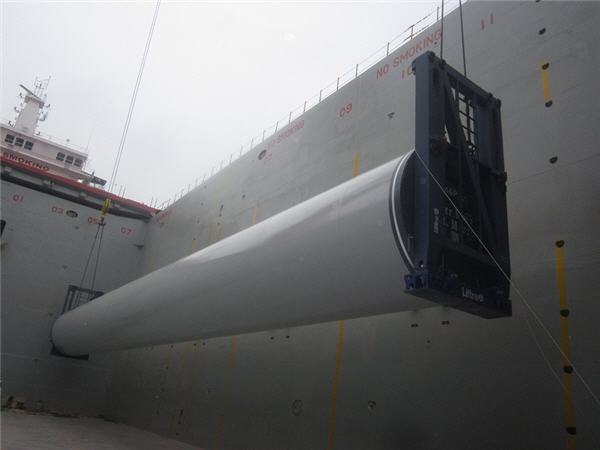 Careful loading is key when handling heavy, sensitive and expensive cargoes
Careful loading is key when handling heavy, sensitive and expensive cargoes
HEAVYLIFTVOY
The HEAVYLIFTVOY form was adopted by BIMCO in early 2007. Whilst it was originally developed from the BIMCO CONLINEBOOKING Note and was intended to create a booking note for the heavy-lift industry, its provisions were ultimately expanded beyond liner terms and the result was a specialist voyage charter rather than a booking note.
HEAVYLIFTVOY operates on the basis of the Hague / Hague-Visby Rules liability regime and is designed for multiple shipments both above and below deck. A standard bill of lading was also issued to accompany the HEAVYLIFTVOY form. Among the many comprehensive clauses in the HEAVYLIFTVOY form, standards have been set for the cargo in respect of its fitness to be transported, how it should be marked and how it should be lifted (i.e. lifting points/ centers of gravity). Provision has also been made for the carrier to have the option of requesting transport drawings for items of sizeable physical dimensions.
A sample copy of the HEAVYLIFTVOY 2007 can be found on BIMCO’s website https://www.bimco.org.
Issuing Bills of Lading
Whilst both the HEAVYCON and the HEAVYLIFTVOY forms are intended to be used in conjunction with their specifically drafted bills of lading, certain issues may nonetheless arise.
For example, the HEAVYLIFTVOY envisages that a different form of bill of lading may be used and incorporates a standard indemnity provision to protect the carrier in cases where a different and more onerous bill of lading is issued than the HEAVYVOYBILL.
Furthermore, where the Hague/Hague-Visby Rules apply to the bill of lading and the cargo in question is damaged, the carrier may argue package limitation. In a circumstance where the cargo is a sole or entire cargo, the number of damages recoverable may then depend on whether the cargo in question has been described in the bill of lading as a single package or unit or whether its weight has been recorded.
 Double checking and “one hand for the boat!”.
Double checking and “one hand for the boat!”.
Minimising risk
- Shipowners should review their Safety Management Systems and perform a risk assessment before any heavy lifting operations are undertaken.
- It is important that lifting operations for heavy cargo are planned properly. The detailed planning should be done jointly by the shipper’s representative, a cargo superintendent and the carrier’s surveyor.
- Detailed information should be provided in relation to the cargo, including a description of the cargo, its gross weight and its principal dimensions (including drawings where appropriate). Where appropriate, vital information such as gross weight and center of gravity should be marked individually on each unit so that it is clearly visible to the crew and stevedores. There should also be a careful assessment of the arrangements at both the load and discharge ports.
- Voyage details, including the weather forecasts and worst case scenarios for stability conditions, should also be studied to promote safe conditions throughout the voyage.
- The lashing material should be checked to confirm that it is appropriate in strength and design for the cargo being secured. The crew should also be alerted to the need to halt any lifting operations in respect of which they have safety concerns.
- The vessel’s cargo-handling equipment (including its onboard cranes) and the cargo spaces should be checked to verify their adequacy. It may be necessary to consult with the vessel’s classification society and flag state to confirm this, particularly where the vessel may need to be modified in any way that requires class approval. The vessel’s Cargo Securing Manual and the IMO’s Code of Safe Practice for Cargo Stowage and Securing should also be consulted. Where a vessel regularly carries heavy-lift cargoes, it may be useful to prepare a standard checklist for loading and discharging such cargoes which can be incorporated into the vessel’s Cargo Securing Manual.
- Finally, ensuring that the loading and discharging of heavy lift cargoes is conducted only during daylight and in suitable weather conditions should minimize the type of risks that arise where heavy lifts are handled during the night. One way of ensuring that this is done is to incorporate suitably drafted provisions in the charter-party.
 Cargo arriving by truck in wooden paneling.
Cargo arriving by truck in wooden paneling.
Cargo stowage and securing
Heavy-lift items and project cargo are often of high value and great weight. They may have delicate parts that must not be contacted and they may or may not be suitable for carriage on deck, which will undoubtedly mean wetting by rain and seawater.
They must be fitted with lifting points and lashing points that are of adequate strength and positioned in appropriate places. The carriage of these items should be planned in great detail from origin to destination. Of particular interest here is the planning of the stowage and securing.
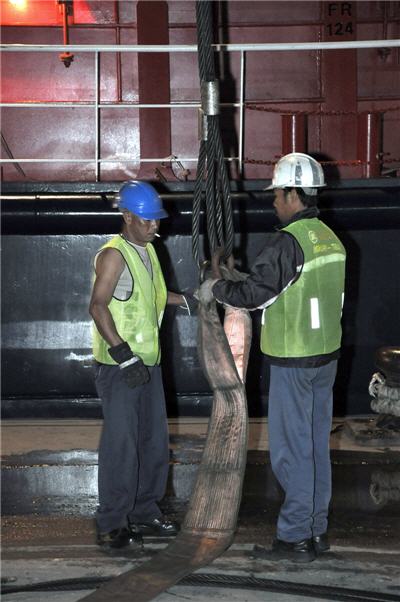 Shore Labour preparing a sling.
Shore Labour preparing a sling.Voyage planning
The voyage must be planned to ensure that the piece of cargo can be safely transported from origin to destination. The points to be borne in mind are as follows.
Voyage planning for heavy-lift items:
- The ship must be able to berth safely alongside at the load port and at the destination port, and safely take on board and finally land the item, bearing in mind mooring arrangements, stability requirements, crane capacity, and crane outreach.
- The load port and destination port must be suitable for the carrying ship. They must also be suitable for carrying vehicles, that is the dockside must be suitable in terms of strength and accessibility.
- Sufficient lashing materials and dunnage materials must be provided on board after appropriate calculations have been carried out to determine the requirements (see pre-planning below).
- Professional securing contractors should be employed, if appropriate, to carry out the necessary calculations and to secure the items in place.
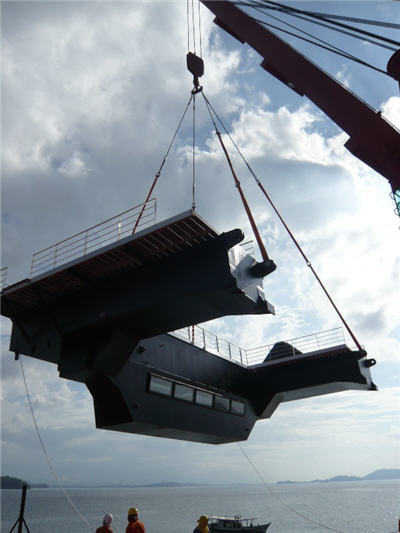 Part of an Observatory being discharged.
Part of an Observatory being discharged.Pre-planning
The shippers of the cargo should provide the master, or representative of the carrier, with information about the cargo so that the stowage and securing can be properly planned in advance. The information should include the following.
Pre-planning information for heavy-lift items
- A general description of the cargo.
- The gross mass of the item or of each item if there are more than one.
- The principal dimensions of the item or items and, if possible, scale drawings.
- The location of the center of gravity of each item.
- Particulars of the bedding area of the cargo units and details of any precautions with regard to the bedding of the item(s).
- Details of lifting points or slinging positions and if possible information on how best to lift each item.
- Details of securing points, including their strength and radius of strength.
Some heavy-lift items are not fitted with any form of bedding arrangements apart from foundations or legs upon which they would ordinarily stand. Others will be completely cased in timberwork and will be provided with a timber floor that is capable of taking and spreading the weight of the item, while others will be fitted with cradles of limited strength.
Information about the construction of base-units is required so that appropriate arrangement can be made on board to bed and support the item adequately and appropriately.
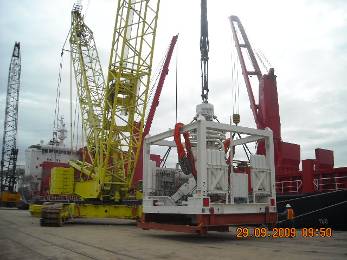 129 mt BOP being loaded by Shore Crane
129 mt BOP being loaded by Shore CraneGeneral requirements for heavy-lift items and stowage planning
- The lifting points should be fitted symmetrically on either side of the center of gravity and should also be fitted with sufficient spread, to be not less than half the length of the unit, to enable safe and level lifting of the unit without the use of additional sling/lengthening equipment. Lifting points should be clearly marked.
- Securing points should be of adequate strength and their minimum strength must be advised. Lashing points should be so constructed as to have a wide arc of strength because lashings will not necessarily be led directly in line with the plane of the lashing point. All lashing points should be suitably marked.
- The strength and base area of any cradles, foundations or bedding provided must be known to establish what else is needed for the support of the load atop the ship’s hatch cover, deck or tank-top, bearing in mind the maximum permissible load.
When details of the base-structure or cradles are known, a suitable stowage location can be chosen and suitable bedding material can be ordered.
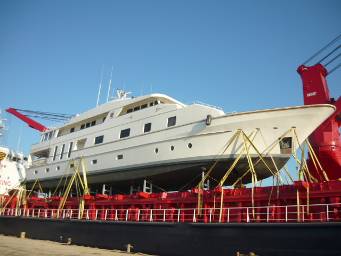
Cradles and cribbage support and securing planning
Some items of cargo comprise a main body and an extension piece or overhanging section that is separate from and is not wholly supported by the main body.
Examples include cranes with a jib, yachts with a horizontally laid mast and pieces of machinery with appendages. Those extending parts must be properly and adequately held and supported to avoid damage being sustained by the parts as a result of movement during the voyage. Such support structures are often referred to as cradles or cribbage supports.
Such structures should be thoughtfully planned and properly constructed, usually of either timber or steel with adequate and appropriate packing materials, and should be as follows.
When the detail of a piece of heavy-lift or project cargo is known, calculations can be carried out to determine how many lashings are required to secure the cargo adequately against movement. Also, the required distribution of those lashings can be assessed.
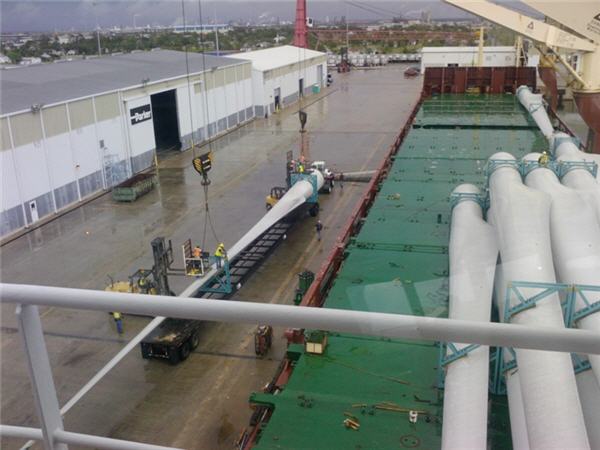 The carriage of heavy lift items should be planned in great detail from origin to destination.
The carriage of heavy lift items should be planned in great detail from origin to destination.
Loading and discharge operations
When all of the pre-planning has been completed, information with regard to the items of cargo obtained, stowage location decided upon and method of securing planned and checked by calculations, consideration needs to be given to the loading operation.
On board a ship that often carries heavy-lift items or project cargoes, either as part of the ISM procedures or within the Cargo Securing Manual, there might be a checklist to be completed when a heavy or awkward piece of cargo is to be loaded.
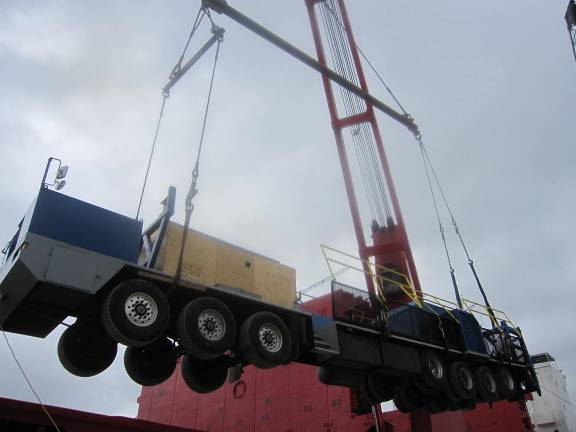
The ship’s checklist should be used to ensure the completion of a safe loading operation and a safe discharge operation. The following list covers all the main points to be borne in mind by the master of a ship during an operation where ship’s crane(s) will be used.
- When all of the preparatory work has been completed the operation can be started, but if any one of the items of the checklist has not been verified, the operation should not begin.
- The master or master’s deputy must be and remain in overall charge of the operation with the signalman in an appropriate position.
- The lifting of the cargo unit should be steady and controlled and the hoist wire(s) of the crane(s) must be vertical throughout the operation.
- When two ship’s cranes are used in tandem, the operation should be carried out only in daylight.
- Taglines should be fitted to the cargo unit to allow control of any rotational movement, if appropriate.
- The ballasting operation should be carried out in conjunction with the cargo transfer operation to maintain the ship as near to upright as possible, and any list should not exceed 3º.
- If, when the cargo unit is first lifted from the quay, it is found that either the weight is in excess of that declared or the center of gravity is not where it is shown to be such that the lifting points are incorrectly positioned, the operation should be abandoned and the cargo unit should be carefully placed back on the quay.
- The situation should then be carefully considered; expert advice should be sought and further information should be obtained to devise a system for the safe loading of the cargo unit.
- If a programme for the safe load of the unit cannot be devised the cargo unit should not be loaded at all.

case studies and lessons learned
Cargo: Parts of a heat recovery steam generator
Stowage location: More than half of the cargo was stowed on deck
Claim: USD 2,000,000
Cause of damage: All cargo stowed on the deck was either lost or heavily damaged as the vessel encountered heavy weather on her voyage.
Cargo: Bulk machinery – parts of hydraulic turbines and generators
Claim: USD 850,000
Cause of damage: The damage was discovered at the discharge port before the commencement of discharge. The damage was likely caused during the loading operation due to bad handling of the cargo or during the voyage due to poor stowage.
Wind Turbine Blades stacked up high on deck.
Lessons learned:
- Always plan the carriage of such specialized cargo in great detail from origin to destination to avoid such large claims.
- Study voyage details, including the weather forecasts and worst case scenarios for stability conditions during the planning stages.
- Always ensure that lifting operations for heavy cargo are properly planned jointly with the shipper’s representative, a cargo superintendent and the carrier’s surveyor.
- For high-value cargo, always use a specialized project cargo surveyor to assist with pre-loading and loading.
- Ensure lashing and dunnage materials are checked to confirm they are appropriate in strength and design for the cargo being secured to avoid damage during the voyage. Where required, professional securing contractors should be employed to carry out the necessary calculations and to secure the items in place.

